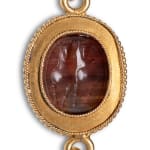Etruscan
An antique archaeological revival gold necklace set with four ancient Etruscan carnelian scarabs, circa 4th - 3rd century BC (scarabs)
Gold and carnelian
Length: 49 cm (19.5 in)
Further images
Each scarab carved on the underside with varying scenes in the al globulo style, including two with two horses, one with three horses, and one with a running warrior.
Each scarab carved on the underside with varying scenes in the al globulo style, including two with two horses, one with three horses, and one with a running warrior.
Provenance
Private collection, Europe, 19th century (from the setting)Blankman Collection, New York, 1950s
with Joseph G. Gerena Fine Art, New York
Private collection, Bahamas, acquired from the above in 1997
Private collection, USA, acquired from the above in 1999











